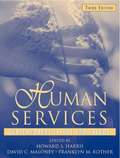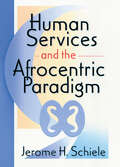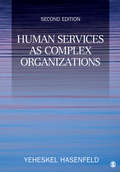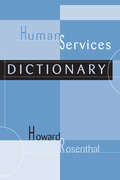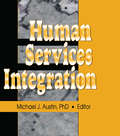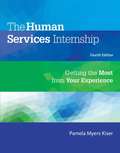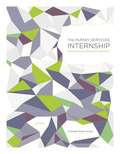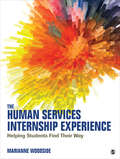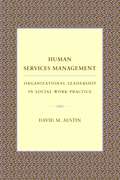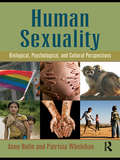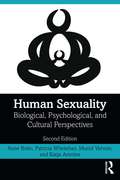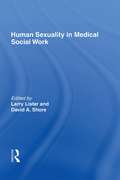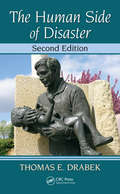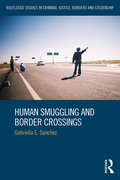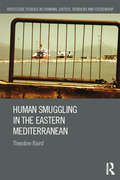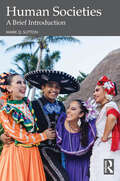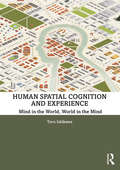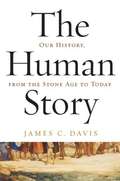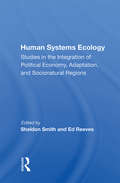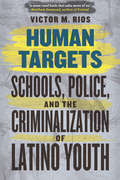- Table View
- List View
Human Services: Contemporary Issues and Trends (3rd edition)
by Howard S. Harris David C. Maloney Franklyn RotherThe third edition of this college textbook features articles on human services theory and application written by 40-plus well-known scholars in the field. The new edition includes new chapters and material on the importance of technology and social change, the effectiveness of the empowerment educational model, the historical roots of human services, techniques and skills for interviewing, the legal foundations of the field, emerging issues and trends affecting human service education and practice, service-learning, social norms theory, architectural design and corrections supervision, and short-term therapy. Annotation ©2004 Book News, Inc., Portland, OR (booknews.com)
Human Services and the Afrocentric Paradigm
by Jerome H SchieleDiscover how human services professionals can help to eliminate cultural oppression!Human Services and the Afrocentric Paradigm presents a new way of understanding human behavior, attacking social problems, and exploring social issues. This excellent guide shows that understanding the simultaneous forces of oppression and spiritual alienation in American society serves as a foundation for understanding the societal problems here. The first book to offer a comprehensive exposition of how the Afrocentric paradigm can be used by human service professionals and community advocates, Human Services and the Afrocentric Paradigm discusses why and how human service work is hampered by Eurocentric cultural values and will help you to offer fair and effective services to your clients. Human Services and the Afrocentric Paradigm provides you with a concrete discription of how the Afrocentric model can be applied in human services to help people of all races and ethnicities. You will expand and diversify your knowledge base in human services by understanding the cultural values, traditions, and experiences of people of African ancestry.Some of the issues and concepts in the Afrocentric paradigm that you will explore are: defining the Afrocentric worldview, complete with a discussion of its philosophical assumptions and its shortcomings understanding traditional helping assumptions and methods of West African societies and how these have influenced the helping strategies of African-Americans exploring the strengths and weaknesses of some early African-American human service scholars, with special concern placed on their rejection of traditional African methods in favor of Eurocentric ideas resolving youth violence and helping people with substance abuse problems examining Afrocentric assumptions about resource distribution, morality, and societal relationships identifying organizational and conceptual differences in Eurocentric and Afrocentric paradigms creating organizational empowerment and an enhanced work environment via the Afrocentric paradigmHuman Services and the Afrocentric Paradigm will help you understand, solve, and prevent problems that are confronted by several races, especially individuals of African descent. This timely and relevant worldview is thoroughly explained to assist you in better serving people of color. The Afrocentric paradigm will help human services practitioners, administrators, policy advocates, analysts, educators, and black studies professors and students achieve educational and treatment objectives by showing you the importance of various cultural values and how to integrate them to make a difference!
Human Services as Complex Organizations
by Dr Yeheskel Hasenfeld"Hasenfeld has done it again. An excellent collection of essays on many of the most important trends and issues involving human service organizations."—Mayer N. Zald, Professor (emeritus), Sociology, Social Work, and Management, University of Michigan The Second Edition of this best-selling text provides a comprehensive and state-of-the-art perspective on human service organizations. This vanguard collection weaves the latest theoretical and empirical studies in macro theory with contemporary examples from hospitals, schools, social service organizations, mental health centers, and public welfare agencies. Blending theory with application, this outstanding anthology highlights the moral choices and accomplishments made by human service organizations. Key Features of This EditionPresents the latest theoretical and empirical studies on human service organizations, offering students key analytical tools to study and understand human behavior in various contexts. Introduces important new topics, such as the impact of the policy environment, emotional labor, and advocacy Offers students a new perspective with original studies on organizational ideologies, conditions of work, structuration of service technologies, diversity, and discretion. Intended Audience This exceptional compilation of the best theoretical and empirical studies on human service organizations is indispensable to graduate students and scholars of organization studies, organizational behavior, and Human Behavior in the Social Environment.
Human Services as Complex Organizations
by Dr Yeheskel Hasenfeld"Hasenfeld has done it again. An excellent collection of essays on many of the most important trends and issues involving human service organizations."—Mayer N. Zald, Professor (emeritus), Sociology, Social Work, and Management, University of Michigan The Second Edition of this best-selling text provides a comprehensive and state-of-the-art perspective on human service organizations. This vanguard collection weaves the latest theoretical and empirical studies in macro theory with contemporary examples from hospitals, schools, social service organizations, mental health centers, and public welfare agencies. Blending theory with application, this outstanding anthology highlights the moral choices and accomplishments made by human service organizations. Key Features of This EditionPresents the latest theoretical and empirical studies on human service organizations, offering students key analytical tools to study and understand human behavior in various contexts. Introduces important new topics, such as the impact of the policy environment, emotional labor, and advocacy Offers students a new perspective with original studies on organizational ideologies, conditions of work, structuration of service technologies, diversity, and discretion. Intended Audience This exceptional compilation of the best theoretical and empirical studies on human service organizations is indispensable to graduate students and scholars of organization studies, organizational behavior, and Human Behavior in the Social Environment.
Human Services Dictionary
by Howard RosenthalWritten in an interesting, accessible and informative manner, with 1600 entries this book is an ideal reference for human service professionals and students preparing for exams. Special features include: extensive cross-referencing, a directory of human service organizations, short biographies of important figures in the profession, a short history of human services, and specialized and slang terms specific to the human service profession.
Human Services in Contemporary America (Ninth Edition)
by William R. BurgerDesigned for introductory college courses in human services, mental-health technology, social work, community mental health, and other human services programs.
Human Services Integration
by Michael J AustinAddressing the multiple meanings of service integration, Human Services Integration analyzes how motivations and expectations for social service integration differ significantly among different players in the service system. In a period of major budget cutbacks and welfare reform, however, it is important that service providers collaborate to reduce or eliminate boundaries between categorically defined and provided services. This book tells you about the efforts being made to provide existing services more efficiently while avoiding duplication and waste. As you will quickly see, developing consensus for service integration efforts at the administrative, community, and staff levels will result in the ability to set achievable goals and objectives and secure cooperation at all levels.Human Services Integration covers practice principles for managing organizational and community change and offers strategies for organizing human service agencies and overcoming fragmented service integration in communities with complex problems and needs. To also help you identify specific service intergration activities that are relevant in the context of unique communities, it discusses: specifications for conducting a self-assessment of progress at the local level toward social service integration goals Georgia&’s Family Connection, a statewide human services initiative interweaving formal and informal systems of care in a community-centered approach to service integration a children’s initiative collaborative social science theory pertinent to service integration gathering support from elected officials such as boards of supervisors, city leaders, and local elected boardsHuman Services Integration will help you understand why service integration cannot be defined by a particular service model or outcome. Its insight will also help you understand why involving service users and community members in the design and delivery of services is fundamental to developing an integrated service system that is culturally competent, empowering, and responsive to its neighborhood and community context.
The Human Services Internship: Getting the most from your Experience
by Pamela Myers KiserChapters focused on ethics, diversity, communication skills, stress management, and other key topics help you integrate your classroom knowledge with your experiences in the field. Supporting you through every stage of the internship process, the book explains what to expect at various points in the internship's development, offers tips for avoiding potential pitfalls, and includes examples of other students' experiences.
The Human Services Internship: Getting the Most from Your Experience (Third Edition)
by Pamela Myers KiserCovering information from the beginning to the end of an internship, this practical, hands-on book engages readers in a process of thinking and reflection--helping them analyze different experiences and situations they encounter day to day in their field work. A unique six-step model guides readers in enhancing self-awareness, integrating the knowledge and values of the profession, recognizing challenging and dissonant situations, decision-making, and follow-through.
The Human Services Internship Experience: Helping Students Find Their Way
by Marianne R. WoodsideThe Human Services Internship Experience: Helping Students Find Their Way aims to help students in field-based courses bridge theory and practice during their internships. The goal is to show students how to apply their academic work in a real-world setting and to confirm and expand their identity as human service professionals.
The Human Services Internship Experience: Helping Students Find Their Way
by Marianne R. WoodsideThe Human Services Internship Experience: Helping Students Find Their Way aims to help students in field-based courses bridge theory and practice during their internships. The goal is to show students how to apply their academic work in a real-world setting and to confirm and expand their identity as human service professionals.
Human Services Management: Organizational Leadership in Social Work Practice (Foundations of Social Work Knowledge Series)
by David AustinHuman services management occurs in nonprofit, governmental, and for-profit sectors and involves a wide variety of organizational structures. These diverse conditions shape the effort to produce and project services that directly affect the quality of life of individuals, families, and communities through social welfare, health and mental health, criminal justice, and educational services. David Austin begins with an examination of the historical development and distinctive characteristics of human service organizations, the variety of organizational and program structures at play, and the connection of individual service organizations with service delivery networks. He then examines of the roles and responsibilities of key stakeholder constituencies, including service users, service personnel (especially service professionals), funders, executives, and policy boards. The final two chapters discuss two organizational processes: accountability for effectiveness and dealing with organizational changes.
Human Sexuality: Biological, Psychological, and Cultural Perspectives
by Anne Bolin Patricia WhelehanHuman Sexuality: Biological, Psychological, and Cultural Perspectives is a unique textbook that provides a complete analysis of this crucial aspect of life around the world. Utilizing viewpoints across cultural and national boundaries, and deftly weaving evolutionary and psychological perspectives, Bolin and Whelehan go beyond the traditional evolution and primatology to address cross-cultural and contemporary issues, as well as anthropological contributions and psycho-social perspectives. Taking into account the evolution of human anatomy, sexual behavior, attitudes, and beliefs, this far-reaching text goes beyond what is found in traditional books to present a wide diversity of beliefs, attitudes, and behaviors found globally. In addition to providing a rich array of photographs, illustrations, tables, and a glossary of terms, this extraordinary textbook explores: pregnancy and childbirth as a bio-cultural experience life-course issues related to gender identity, sexual orientations, behaviors, and lifestyles socioeconomic, political, historical, and ecological influences on sexual behavior early childhood sexuality, puberty and adolescence birth control, fertility, conception, and sexual differentiation HIV infection, AIDS, AIDS globalization and sex work Fusing biological, socio-psychological, and cultural influences to offer new perspectives on understanding human sexuality, its development over millions of years of evolution, and how sexuality is embedded in specific socio-cultural contexts, this is the text for educators and students who wish to understand human sexuality in all of its richness and complexity.
Human Sexuality: Biological, Psychological, and Cultural Perspectives
by Anne Bolin Patricia Whelehan Muriel Vernon Katja AntoineThis groundbreaking second edition of Human Sexuality continues its broad and interdisciplinary goal of providing readers with a comprehensive overview on sexuality as a core part of our individual identities and social lives. Edited by anthropological experts on the subject, this unique textbook integrates evolutionary and cultural aspects to provide a fully interdisciplinary approach to human sexuality that is rare in this area of scholarship. Fully updated throughout in line with developments in the field, this second edition includes fresh material exploring new sexual identities, sexual violence and consent, Internet pornography, conversion therapy, polyamory, and much more. In addition to providing a rich array of photographs, illustrations, tables, and a glossary of terms, this textbook explores: pregnancy and childbirth as a bio-cultural experience life-course issues related to gender identity, sexual orientations, behaviors, and lifestyles socioeconomic, political, historical, and ecological influences on sexual behavior early childhood sexuality, puberty, and adolescence birth control, fertility, conception, and sexual differentiation HIV infection, AIDS, AIDS globalization, and sex work. Utilizing viewpoints across cultural and national boundaries and taking into account the evolution of human anatomy, sexual behavior, attitudes, and beliefs across the globe, Human Sexuality, Second Edition, remains an essential text for educators and students who wish to understand human sexuality in all of its richness and complexity.
Human Sexuality in Medical Social Work
by H Lawrence Lister David A ShoreParticularly valuable to social workers and health care personnel, this timely volume offers practical guidelines and unique treatment approaches to use with clients who have sex-related problems. Experts address sexual health and social work intervention in sexual problems. They also present important information on significant health problems--cancer, chronic illness; patient characteristics; and special issues, which illustrate the various social work intervention responses available to meet patients’sexual problems.
The Human Side of Disaster
by Thomas E. DrabekSince the first edition of The Human Side of Disaster was published in 2009, new catastrophes have plagued the globe, including earthquakes in Haiti and New Zealand, tornadoes in Alabama and Missouri, floods in numerous locations, Hurricane Sandy, and the infamous BP oil spill. Enhanced with new cases and real-world examples, The Human Side of Disaster, Second Edition presents an updated summary of the social science knowledge base of human responses to disaster. Dr. Drabek draws upon his 40-plus years of conducting research on individual, group, and organizational responses to disaster to illustrate and integrate key insights from the social sciences to teach us how to anticipate human behaviors in crisis. The book begins with a series of original short stories rooted within actual disaster events. These stories are woven into the entire text to demonstrate essential findings from the research literature. Dr. Drabek provides an overview of the range of disasters and hazards confronting the public and an explanation of why these are increasing each year, both in number and scope of impact. The core of the book is a summary of key findings regarding disaster warning responses, evacuation behavior, initial post-impact survival behavior, traditional and emergent roles of volunteers, and both short-term and longer-term disaster impacts. The theme of "organized-disorganization" is used to illustrate multiorganizational response networks that form the key managerial task for local emergency managers. The final chapter provides a new vision for the emergency management profession—one that reflects a more strategic approach wherein disasters are viewed as non-routine social problems. This book will continue to be an invaluable reference for professionals and students in emergency management and public policy and aid organizations who need to understand human behavior and how best to communicate and work with the public in disaster situations.
Human Smuggling and Border Crossings (Routledge Studies in Criminal Justice, Borders and Citizenship)
by Gabriella SanchezGraphic narratives of tragedies involving the journeys of irregular migrants trying to reach destinations in the global north are common in the media and are blamed almost invariably on human smuggling facilitators, described as rapacious members of highly structured underground transnational criminal organizations, who take advantage of migrants and prey upon their vulnerability. This book contributes to the current scholarship on migration by providing a window into the lives and experiences of those behind the facilitation of irregular border crossing journeys. Based on fieldwork conducted among coyotes in Arizona - the main point of entry for irregular migrants in the United States by the turn of the 21st Century - this project goes beyond traditional narratives of victimization and financial exploitation and asks: who are the men and women behind the journeys of irregular migrants worldwide? How and why do they enter the human smuggling market? How are they organized? How do they understand their roles in transnational migration? How do they explain the violence and victimization so many migrants face while in transit? This book is suitable for students and academics involved in the study of migration, border enforcement and migrant and refugee criminalization.
Human Smuggling in the Eastern Mediterranean (Routledge Studies in Criminal Justice, Borders and Citizenship)
by Theodore BairdThe organization of human smuggling from the Middle East and Africa through Turkey and the Eastern Mediterranean has become a contemporary political concern throughout Europe, receiving intense and polarised media attention. This timely book reformulates how we conceive of human smuggling, challenging popular and political conceptions of the practice in Europe. This book proposes a new framework for examining the causes and effects of human smuggling in the Mediterranean, analysing the contingent patterns of human smuggling in the countries of the Eastern Mediterranean with a geographic focus on Turkey. Building on unique empirical material from fieldwork in Turkey and Greece, this book describes the rise of human smuggling as a practice, viewed through a framework of multiple 'contingencies'. Uniquely, this book includes in-depth testimonies of migrants who have survived crossing the Aegean Sea and details the strategies and tactics of the facilitators who help them. In Human Smuggling in the Eastern Mediterranean, Theodore Baird puts a human face to the tragedies occurring in the Mediterranean while maintaining that contingent historical, political, economic, and geographic forces have aligned to propel the practice of human smuggling forward. The book will be of interest to scholars working in migration studies, as well as scholars in the fields of sociology, criminology, law, political science, anthropology, and geography.
Human Societies: A Brief Introduction
by Mark Q. SuttonHuman Societies: A Brief Introduction succinctly covers the basic concepts of cultural anthropology in a way that is relevant and engaging to the introductory student. Less time is spent on anthropological detail and more time on the relevance of anthropological understanding to the contemporary world.The issues facing the contemporary Western world are also confronting the thousands of other societies. The book deals with topics such as the variety of sexualities, the thousands of religions, how people adapt to their environments, the ways people organize themselves, the multitude of foods and cuisines, adaptations to climate change, refugees and migrants, and the many different approaches to reproduction; all topics to which students should already be generally aware. Included are succinct chapters discussing personality; adaptation; social, political, and economic organization; food and diet; sex and gender; religion and ritual; and change and development. The book also includes short “Spotlight” boxes that enlighten the reader about specific topics of interest, as well as chapter summaries, exercises, key terms, and a comprehensive glossary.Human Societies: A Brief Introduction is essential reading for undergraduate students taking their first steps into cultural and applied anthropology.
Human Spatial Cognition and Experience: Mind in the World, World in the Mind
by Toru IshikawaThis book offers students an introduction to human spatial cognition and experience and is designed for graduate and advanced undergraduate students who are interested in the study of maps in the head and the psychology of space. We live in space and space surrounds us. We interact with space all the time, consciously or unconsciously, and make decisions and actions based on our perceptions of that space. Have you ever wondered how some people navigate perfectly using maps in their heads while other people get lost even with a physical map? What do you mean when you say you have a poor "sense of direction"? How do we know where we are? How do we use and represent information about space? This book clarifies that our knowledge and feelings emerge as a consequence of our interactions with the surrounding space, and show that the knowledge and feelings direct, guide, or limit our spatial behavior and experience. Space matters, or more specifically space we perceive matters. Research into spatial cognition and experience, asking fundamental questions about how and why space and spatiality matters to humans, has thus attracted attention. It is no coincidence that the 2014 Nobel Prize in Physiology or Medicine was awarded for research into a positioning system in the brain or "inner GPS" and that spatial information and technology are recognized as an important social infrastructure in recent years. This is the first book aimed at graduate and advanced undergraduate students pursuing this fascinating area of research. The content introduces the reader to the field of spatial cognition and experience with a series of chapters covering theoretical, empirical, and practical issues, including cognitive maps, spatial orientation, spatial ability and thinking, geospatial information, navigation assistance, and environmental aesthetics.
The Human Story
by James C. DavisHas there ever been a history of the world as readable as this? In The Human Story, James C. Davis takes us on a journey to ancient times, telling how peoples of the world settled down and founded cities, conquered neighbors, and established religions, and continues over the course of history, when they fought two nearly global wars and journeyed into space. Davis's account is swift and clear, never dull or dry. He lightens it with pungent anecdotes and witty quotes. Although this compact volume may not be hard to pick up, it's definitely hard to put down. For example, on the death of Alexander the Great, who in a decade had never lost a single battle, and who had staked out an empire that spanned the entire Near East and Egypt, Davis writes: "When they heard how ill he was, the king's devoted troops insisted on seeing him. He couldn't speak, but as his soldiers -- every one -- filed by in silence, Alexander's eyes uttered his farewells. He died in June 323 B.C., at the ripe old age of thirty-two." In similar fashion Davis recounts Russia's triumph in the space race as it happened on an autumn night in 1957: "A bugle sounded, flames erupted, and with a roar like rolling thunder, Russia's rocket lifted off. It bore aloft the earth's first artificial satellite, a shiny sphere the size of a basketball. Its name was Sputnik, meaning 'companion' or 'fellow traveler' (through space). The watchers shouted, 'Off. She's off. Our baby's off!' Some danced; others kissed and waved their arms." Though we live in an age of many doubts, James C. Davis thinks we humans are advancing. As The Human Story ends, he concludes, "The world's still cruel; that's understood, / But once was worse. So far so good."
The Human Story (First Edition): An Introduction To Anthropology
by Alexandra Brewis Amber Wutich Cindi SturtzSreetharan Kelly Knudson Christopher StojanowskiThe only true four-fields introduction to anthropology The Human Story is the first general anthropology textbook written by award-winning scholars and teachers from all four of the discipline’s subfields. In each chapter, the authors weave perspectives from cultural anthropology, biological anthropology, archaeology, and linguistic anthropology into an engaging narrative, inviting students to think anthropologically about themselves and the world around them.?By emphasizing contemporary research from a diverse cast of anthropologists, the authors provide students with a uniquely holistic, balanced, and up-to-date view of the discipline. To provide students with the most effective possible learning experience, a dynamic media package features a Norton Illumine Ebook with animations and Anthropology in 3D models. This purchase offers access to the digital ebook only.
The Human Swarm: How Our Societies Arise, Thrive, and Fall
by Mark W. MoffettThe epic story and ultimate big history of how human society evolved from intimate chimp communities into the sprawling civilizations of a world-dominating species <P><P>If a chimpanzee ventures into the territory of a different group, it will almost certainly be killed. But a New Yorker can fly to Los Angeles--or Borneo--with very little fear. <P><P>Psychologists have done little to explain this: for years, they have held that our biology puts a hard upper limit--about 150 people--on the size of our social groups. But human societies are in fact vastly larger. How do we manage--by and large--to get along with each other? <P><P>In this paradigm-shattering book, biologist Mark W. Moffett draws on findings in psychology, sociology and anthropology to explain the social adaptations that bind societies. He explores how the tension between identity and anonymity defines how societies develop, function, and fail. <P><P>Surpassing Guns, Germs, and Steel and Sapiens, The Human Swarm reveals how mankind created sprawling civilizations of unrivaled complexity--and what it will take to sustain them.
Human Systems Ecology: Studies In The Integration Of Political Economy, Adaptation, And Socionatural Regions
by Sheldon Smith Ed ReevesThis book presents nine case studies which illustrate an approach to the interface between human ecology, political economy, and adaptive decision making, demonstrating the power of analyzing socionatural regions from a human systems ecology perspective.
Human Targets: Schools, Police, and the Criminalization of Latino Youth
by Victor M. RiosAt fifteen, Victor Rios found himself a human target—flat on his ass amid a hail of shotgun fire, desperate for money and a place on the street. Faced with the choice of escalating a drug turf war or eking out a living elsewhere, he turned to a teacher, who mentored him and helped him find a job at an auto shop. That job would alter the course of his whole life—putting him on the road to college and eventually a PhD. Now, Rios is a rising star, hailed for his work studying the lives of African American and Latino youth. In Human Targets, Rios takes us to the streets of California, where we encounter young men who find themselves in much the same situation as fifteen-year-old Victor. We follow young gang members into schools, homes, community organizations, and detention facilities, watch them interact with police, grow up to become fathers, get jobs, get rap sheets—and in some cases get killed. What is it that sets apart young people like Rios who succeed and survive from the ones who don’t? Rios makes a powerful case that the traditional good kid/bad kid, street kid/decent kid dichotomy is much too simplistic, arguing instead that authorities and institutions help create these identities—and that they can play an instrumental role in providing young people with the resources for shifting between roles. In Rios’s account, to be a poor Latino youth is to be a human target—victimized and considered an enemy by others, viewed as a threat to law enforcement and schools, and burdened by stigma, disrepute, and punishment. That has to change. This is not another sensationalistic account of gang bangers. Instead, the book is a powerful look at how authority figures succeed—and fail—at seeing the multi-faceted identities of at-risk youths, youths who succeed—and fail—at demonstrating to the system that they are ready to change their lives. In our post-Ferguson era, Human Targets is essential reading.
